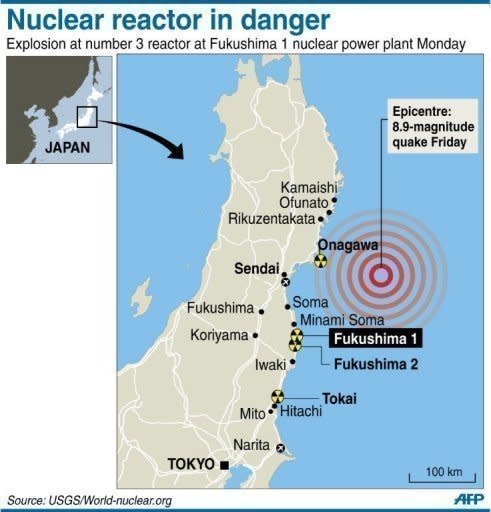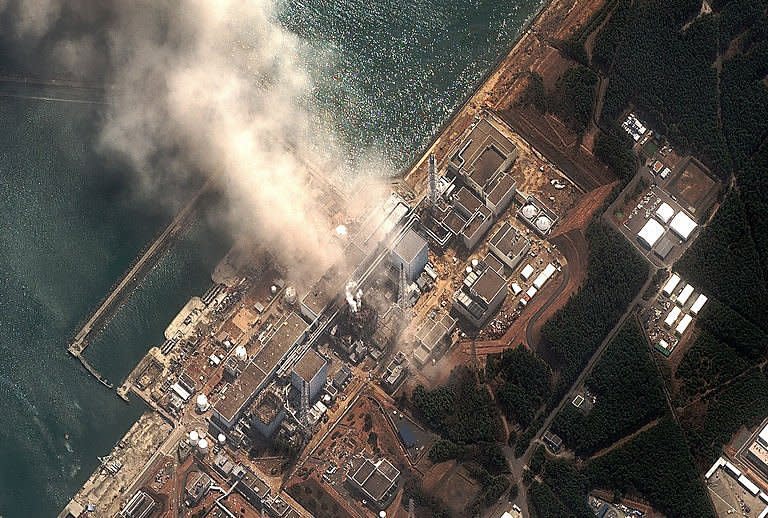Japan scrambles as reactor container 'damaged'
The container around an overheating nuclear reactor appears to be damaged, Japan's government said Tuesday, raising the chance that dangerous radiation could leak from the quake-hit plant. The announcement came as engineers scrambled to keep the temperature of three reactors under control after they were hit by the tsunami that swept Japan following Friday's massive earthquake. Rescue teams searching through the shattered debris of whole villages swept away by the wall of water on Japan's northeast coast found 2,000 bodies in the region of Miyagi. Scene: Japan in survival mode after quake Millions have been left without water, electricity, fuel or enough food and hundreds of thousands more were homeless after the monster waves engulfed whole towns. More than 10,000 people were feared to have perished in one prefecture alone in the aftermath of an earthquake US seismologists said had a magnitude of 9.0, raising their previous estimate of its strength. Eyes were on the Tokyo stock exchange early Tuesday after punishing losses a day earlier that sent markets around the world sliding. Panic selling saw stocks close more than six percent lower on the Tokyo bourse Monday on fears for the world's third-biggest economy, as power shortages prompted rolling blackouts and factory shutdowns in quake-hit areas. Kaori Ohashi, 39, a mother-of-two working in a facility for the elderly with severe dementia near Sendai, spent two nights trapped in the building after its first floor was submerged by Friday's tsunami. "Snow started to fall and it became dark. We lost power. I thought 'This is a nightmare'," Ohashi told AFP after she was rescued. Scene: Japanese towns become wastelands The police chief in Miyagi prefecture, which includes Sendai and which took the full force of the massive tsunami, said the death toll was certain to exceed 10,000 in his region alone. At least 1.4 million people in Japan were temporarily without running water and more than 500,000 were taking shelter in evacuation centres, said the UN's Office for the Coordination of Humanitarian Affairs. At a hospital in the fishing town of Kesennuma hit by the tsunami, an official said basics supplies were desperately needed. "We are critically short of water. Water is very important here. To save it, we need a lot of disposable dishes. We need blankets as well." A tearful elderly woman in the devastated town of Minamisanriku told public broadcaster NHK: "I need to go to hospital. I need medicine." But it was the fear of a nuclear disaster on top of the devastating quake that gripped the nation as it struggled with a crisis described by Prime Minister Naoto Kan as the worst since World War II. Focus: Japan quake threatens setback for nuclear energy Chief Cabinet Secretary Yukio Edano told reporters Tuesday that "damage appears on the suppression pool" of one of the reactors -- the bottom part of the container, which holds water used to cool down the reactor and control air pressure inside. "But we have not recorded any sudden jump in radiation indicators," Edano added. Explosions have previously rocked two overheating reactors at the ageing Fukushima plant, 250 kilometres (160 miles) northeast of Tokyo, after the cooling systems were knocked out. Scene: Foreigners, wary of nuclear risk, flee Tokyo A first explosion blew apart the building surrounding the plant's No 1 reactor on Saturday but the seal around the reactor itself remained intact, officials said. On Monday, shortly after Kan said the plant was still in an "alarming" state, a blast at its No 3 reactor shook the facility, injuring 11 people and sending plumes of smoke billowing into the sky. Plant operator TEPCO reported the rods in the No 2 reactor were fully exposed and the UN's nuclear watchdog, the IAEA, said Tokyo had asked for expert assistance. But Yukiya Amano, the head of the International Atomic Energy Agency, moved to calm global fears that the situation could escalate to match the world's worst nuclear crisis at Chernobyl in Ukraine in 1986. Facts: Fukushima nuclear plant "Let me say that the possibility that the development of this accident into one like Chernobyl is very unlikely," he told reporters in Vienna, adding the "design is different and the structure is different." For the Japanese government, Edano said a major explosion was unlikely at the reactor. Engineers were pumping seawater in to stabilise it and radiation around the plant was at tolerable levels, he said. The World Health Organization said that there was minimal public health risk from the nuclear reactors. Officials have already declared an exclusion zone within a 20-kilometre radius of the plant and evacuated 210,000 people. At one shelter, a young woman holding her baby told public broadcaster NHK: "I didn't want this baby to be exposed to radiation. I wanted to avoid that, no matter what." Aid workers and search teams from across the world joined 100,000 Japanese soldiers in a massive relief push as the country suffered a wave of major aftershocks and a false alarm over a new tsunami. The foreign ministry expressed its "heartfelt appreciation" for offers of help pouring in from around the world, and said rescue teams from 11 countries including China were now on the ground. Focus: Digital ways to donate to Japan disaster relief With ports, airports, highways and manufacturing plants shut down, the government has predicted "considerable impact on a wide range of our country's economic activities". Leading risk analysis firm AIR Worldwide said the quake alone would exact an economic toll estimated at between $14.5 billion and $34.6 billion (10 billion to 25 billion euros) -- even leaving aside the effects of the tsunami. Rolling blackouts began across the nation in a bid to save power, with the heavily nuclear-dependent nation rocked by the crisis at Fukushima as well as an oil refinery fire. Scene: Outrunning the deadly tsunami The UN said power and gas supplies were critical, with the Japanese winter bringing sub-zero temperatures overnight and snow and rain forecast for coming days. Russia said it was ready to divert 6,000 MW of electricity from its far east to help Japan deal with the power shortfall. Miki Otomo told how her sister managed to escape the tsunami's black tide of wrecked houses and cars near Sendai. "My older sister was in a bus when the wave came behind them. The bus driver told everybody to get out of the bus and run," Otomo told AFP. "My sister was able to get away but some people just couldn't run fast enough." Otomo is now staying at an evacuation centre in a local school with about 1,000 other exhausted survivors who cheated death. "We need food and clothes. Everyone had to run away before grabbing things to wear," one woman at a shelter in the small port city of Minamisanriku, where authorities say 10,000 people are unaccounted for, she told NHK.








